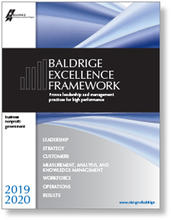Blogrige
The Official Baldrige Blog


University of Wisconsin-Stout
2001 Baldrige Award Recipient
Nearly two decades ago, the University of Wisconsin-Stout (UW-Stout) became the nation’s first four-year university to earn the prestigious Malcolm Baldrige National Quality Award. A few years ago, we interviewed leaders of the state polytechnic university so we could share how they’ve continued to leverage the Baldrige framework for continuous improvement and innovation.
As a new chancellor assumed leadership of UW-Stout this year, we asked her about her views and aims for the Baldrige Award-winning university in regard to continuous improvement and excellence. The interview with UW-Stout Chancellor Dr. Katherine Frank follows.
Could you please tell us about your past organizational leadership experiences and how you aim to benefit UW-Stout?
I have spent my career in higher education at public, comprehensive universities. I began as an assistant professor of English and director of composition, and I took a traditional leadership route through academic affairs: department chair, dean, provost, chancellor. One of my profound leadership experiences was serving as faculty senate president at Colorado State University-Pueblo during a time when complex issues were discussed and long-lasting decisions were made. That experience strengthened my commitment to visionary, transparent leadership and to inclusive decision making and an organizational culture that builds trust and confidence.
I am most proud of my involvement in decisions that continue to positively impact institutions and communities. For example, I hired several personnel who have become exceptional leaders, and I initiated the formation of the School of the Arts at Northern Kentucky University and the creation of an associate provost of extended learning and outreach [position] at Central Washington University. The former has strengthened fundraising, programs, and visibility, and the latter has improved online programming and outreach efforts.
The effectiveness and uniqueness of the institution is truly the sum of its parts. As a result, I believe effective leadership depends on reciprocal relationships across the institution’s internal and external network, as well as on valuing people to leverage everyone’s passions, strengths, and expertise. In addition, my training as a humanist and my experience at other public institutions enable me to view UW-Stout’s polytechnic mission from a different vantage point and to provide a fresh perspective to the institution and our stakeholders. I bring a new way of seeing to the institution, and this helps to inform the conversation and work moving forward and creates an environment for success.
Tell us about how your first weeks of serving as chancellor may have impacted your perspective on your goals for UW-Stout?
Within a few days of taking office as chancellor at UW-Stout, I found myself leading an institution during an international crisis. Entering the current crisis a week after arriving at UW-Stout was difficult, but it allowed me to see the talent and dedication at the institution. I am surrounded by an incredible leadership team and privileged to work with such remarkable and generous students and faculty and staff members. This experience reminded me of the importance of valuing people and of providing support not only through this crisis, but well beyond it. Recovery will depend on our ability to take what we have learned and apply it going forward. One thing we have learned is that we must take time to communicate, learn from, motivate, and support one another through various channels. This moment has forced us to find the space and time for such connection and to think about how to foster it going forward.
Leading through a crisis has also helped us to identify opportunities for improvement in our approaches and deployment. Through multiple avenues for two-way communication, we are tracking gaps and barriers in processes, policies, and procedures. We are developing action plans to address them as part of our recovery plan and integrating them into our strategic planning process. In addition, we are working on a case study so we can share our key learning with others.
What do you see as the value for a university today of using the Baldrige Excellence Framework (including the Education Criteria for Performance Excellence)?
Baldrige provides a nonprescriptive framework based on key factors important to the organization. We appreciate that it is not a one-size-fits-all or checklist approach to performance excellence.
This approach helps us during good times—as well as challenging times like we face today. It keeps us focused on what is most important when making decisions about how to invest our time and limited resources.
Baldrige also informs our approach to visioning and strategy development. At our spring Visioning Session to kick off our next strategic plan, we plan to share our organizational profile, examine core competencies, and refine our performance-improvement and process-improvement processes.
Plus, the Baldrige framework is beneficial in that we can learn from sectors outside of higher education. Communication and direct contact with stakeholders are key, and we have adopted an approach that draws from the health care sector’s use of “rounding.” Although my plans for face-to-face visits with all academic departments, student organizations, and others have been prevented by the current quarantine, I continue to focus on communication. I hold open office hours twice a week via Microsoft Teams, meet with academic departments and other units remotely, and record messages for student organizations conducting virtual celebrations. The current crisis has reminded us of the importance of communication, collaboration, and community building, and I have spent much of my time connecting in various ways with different constituent groups.
How do you view UW-Stout’s status as the first and (to-date) only four-year university in the nation to have earned a Baldrige Award?
We are extremely proud of our status. It is important to share our story so others can learn from us, and it is important to participate in Baldrige events so we can learn from others and continue to improve.
Against the backdrop of current challenges, our strengths in planning and our commitment to shared governance have become even more evident and essential. We are well equipped to systematically track and fill gaps, which will maximize our effectiveness during this period of operational adjustment and during the recovery process. Collecting formative assessment from all institutional stakeholders has been a priority; it has increased our agility in addressing concerns quickly and will remain a priority.
Looking ahead, what’s next for UW-Stout in terms of continuous improvement and innovation?
In summer 2020, we will fully launch the University Benchmark Project, a national initiative for data sharing and benchmarking at the unit level. In addition, in alignment with our ambitious vision statement to be an international leader, we will explore opportunities to enhance our international presence, including through the expansion of programs and initiatives. We are also enhancing our strategy development process, including changing our longer-term planning horizon to ten years. This change will help us stimulate and incorporate more innovation and promote more intelligent risk taking.
To help boost morale during this challenging time, ignite innovation, and plan for recovery, we established a modest innovation fund. Faculty and staff members have been invited to submit proposals for projects that will address issues associated with the pandemic and have a lasting, positive impact on the university community. Proposals will be vetted by a committee, which will make recommendations to the chancellor for possible funding.
What would you say to leaders of other education organizations that are using or considering the Baldrige framework to improve their operational effectiveness and promote academic excellence?
Use it! You don’t have to start by submitting a [Baldrige Award] application or by becoming a Baldrige examiner. You can implement the Baldrige framework in small steps. Start by completing an Organizational Profile, by attending conferences and workshops hosted by your state Baldrige program, or by talking with Baldrige Award recipients. In fact, we plan to bring together people within higher education to talk about how the Baldrige framework can help educational organizations learn and grow at the fall 2020 Baldrige conference.

Baldrige Excellence Framework
The Baldrige Excellence Framework has empowered organizations to accomplish their missions, improve results, and become more competitive. It includes the Criteria for Performance Excellence, core values and concepts, and guidelines for evaluating your processes and results.
Purchase your copy today!
Available versions: Business/Nonprofit, Education, and Health Care





